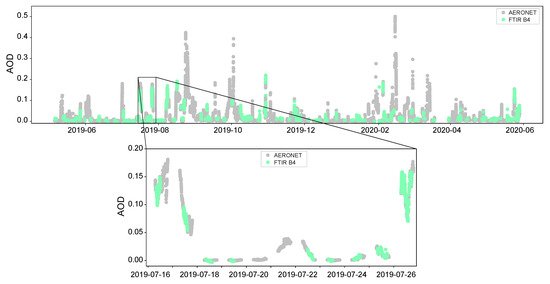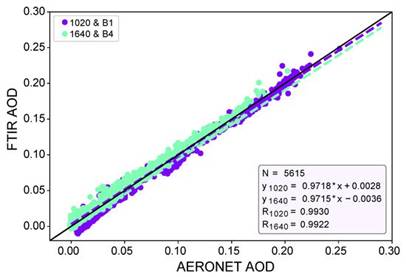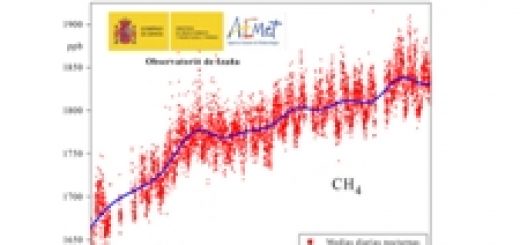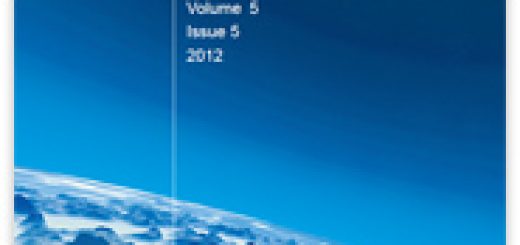Publication of the Paper “Spectral Aerosol Optical Depth Retrievals by Ground-Based Fourier Transform Infrared Spectrometry” –
Considered as an “essential climate variable” by the Global Climate Observing System (GCOS) World Meteorological Organization (WMO) programme, atmospheric aerosols exert an important influence on the Earth–atmosphere radiative balance from the ultraviolet (UV) to the infrared (IR) region. However, the accurate knowledge of the different aerosol–climate interactions is especially challenging in the IR, where there is an important lack of aerosol spectral information as reference.
The scientific paper “Spectral Aerosol Optical Depth Retrievals by Ground-Based Fourier Transform Infrared Spectrometry” has been recently published in Remote Sensing Journal, showing the first long-term (1 year) series of aerosol optical depth (AOD) and Angström Exponent (AE) in the near infrared (NIR) and the short-wave infrared (SWIR) spectral regions from ground-based high-quality spectroscopic measurements (Figure 1). These results were obtained by means of a Fourier Transform Infrared (FTIR) spectrometer installed in the Global Atmosphere Watch (GAW) high mountain station (Tenerife, Canary Islands, Spain). Despite being a high-resolution and high-quality technique for atmospheric gas monitoring, the lack of absolute photometric stability of the FTIR system required for aerosol monitoring has prevented expanding the FTIR capability for aerosol monitoring (which can be performed simultaneously with the atmospheric gas monitoring). This study revealed that the FTIR absolute calibration is very sensitive to the surface degradation or dirtiness deposited on the FTIR external optical mirrors (with a linear degradation rate up to 1.75%month−1). This lack of FTIR absolute photometric stability was addressed in this paper by means of a continuous Langley–Plot procedure based on 29 different Langley–Plots smoothed with a spline smoothing method.

Figure 1. Time series of the AERONET and FTIR AOD values from May 2019 to May 2020 at IZO for FTIR B4 and AERONET channel centred at 1640 nm: the AOD evolution in a 11-day period in July 2019 is also displayed in the zoom.
The 1-year AOD series has been cross-validated with co-located Cimel CE318-T photometric observations in the framework of the Aerosol Robotic Network (AERONET), showing an excellent agreement between both AOD products (Figure 2). The reliability of the FTIR dataset was additionally ensured by means of a subsequent cross-validation with the MOPSMAP (Modeled optical properties of ensembles of aerosol particles) package.

Figure 2. Scatterplot for the coincident AERONET-FTIR AOD values from May 2019 to May 2020 considering the FTIR B1 and B4 micro-windows: the number of coincidences (N), the fitting parameters, and correlation coefficient (R) are displayed in the legend.
The general conclusion that can be extracted from this paper is that these new IR products provide important additional information for the validation and subsequent improvement of satellite aerosol products as well as enhance the sensitivity to large particles of the existing databases, required to improve the estimation of the aerosols’ radiative effect on climate. In addition, these results are expected to serve as a first step to be applied to FTIR portable low-resolution FTIR instruments, with a potentially higher spatial coverage for atmospheric monitoring.
The full reference is: Barreto, A.; García, O. E.; Schneider, M.; García, R. D.; Hase, F; Sepúlveda, E.; Almansa, A. F.; Cuevas, E.; Blumenstock, T. Spectral Aerosol Optical Depth Retrievals by Ground-Based Fourier Transform Infrared Spectrometry. Remote Sens. 2020, 12 (19), 3148. Accesible at https://www.mdpi.com/838110.



